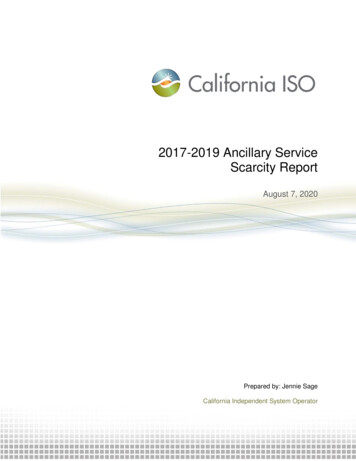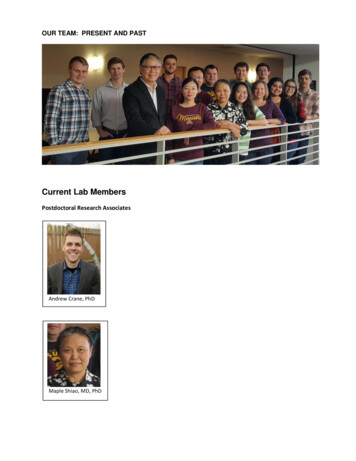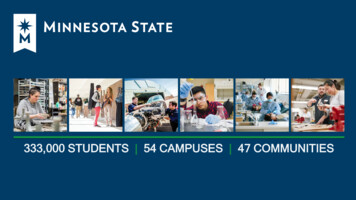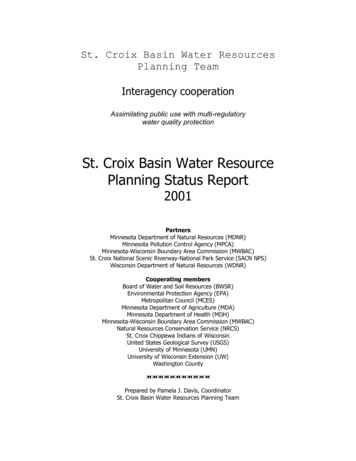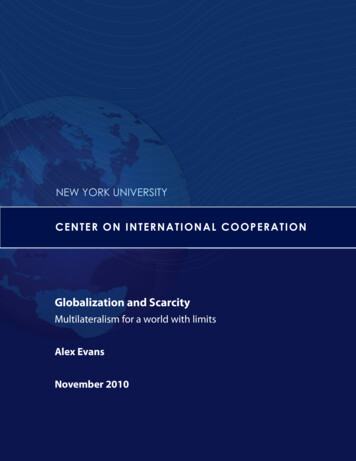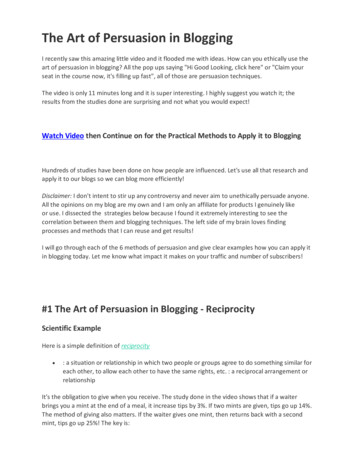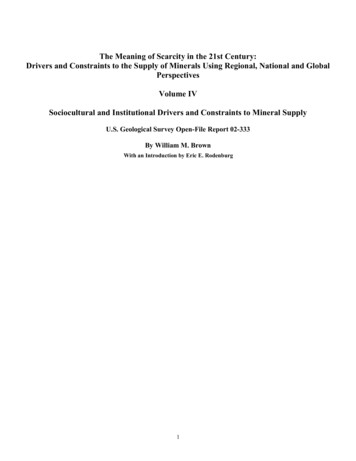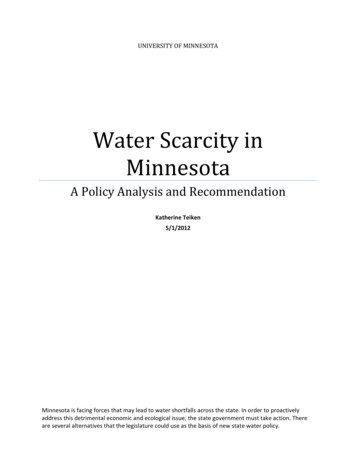
Transcription
UNIVERSITY OF MINNESOTAWater Scarcity inMinnesotaA Policy Analysis and RecommendationKatherine Teiken5/1/2012Minnesota is facing forces that may lead to water shortfalls across the state. In order to proactivelyaddress this detrimental economic and ecological issue, the state government must take action. Thereare several alternatives that the legislature could use as the basis of new state water policy.
Page 1Table of ContentsChapter One: Introduction . 3Problem Definition . 3Purpose of Study . 3Evidence . 3Water Trends . 3Consumption . 6Minnesota’s Issues . 9Chapter Two: Literature Review . 14Introduction . 14Opening . 14Research Problem . 14Outline for Literature Review . 15Body of Review and Alternatives . 16State Governing . 16Economics and Water . 19Eliminating Water Waste . 23Summary . 28Chapter Three: Discussion . 29Introduction . 29Purpose and Design of Study . 29Policy Criteria . 29Effectiveness . 29Cost‐Benefit . 29Feasibility . 29Equity . 29Environmental Health & Safety . 30Longevity . 30Flexibility . 30Trade‐Offs of Alternatives . 30Trade‐Offs: Government Options . 30Trade‐Offs: Permitting . 31
Page 2Trade‐Offs: Taxes . 31Trade‐Offs: Subsidies . 32Trade‐Offs: Markets . 32Trade‐Offs: Water Pricing . 33Trade‐Offs: Infrastructure Options . 35Trade Offs: Conservation . 37Trade‐Offs: Education . 38Limitations. 39Conclusions and Policy Recommendations. 39Chapter Four: Appendices . 42Appendix A: Stakeholder Analysis. 42Appendix B: Policy Analysis Criteria . 44Chapter 5: Bibliography . 46
Page 3Chapter One: Introduction"Anyone who solves the problem of water deserves not one Nobel Prize but two ‐ one for science and the7other for peace." President John F. KennedyProblem Definition54Minnesota may have abundant water but it is not limitless and not evenly distributed across the state.Some areas of the state have limited water resources while others areas have water resources that areplentiful. Despite this disparity, the residents of Minnesota tend to take water for granted. They51generally expect to find water available everywhere within the state at minimal cost. The problem thatMinnesota faces is some locations within Minnesota may experience shortages of clean water by 2030.What policy changes can the state of Minnesota make in order to bring future water demand in balancewith water supply without negatively influencing the state economy and local businesses?Purpose of StudyThe purpose of this study is to understand how the state government of Minnesota can work with highintensive water users to address growing water demand in Minnesota. There are several needs andrationales for doing this study. One reason for this study is that as water demand increases around theUnited States, the availability of water may become a major factor in economic decision‐making. With32this, it is likely that the price of water will rise to reflect its true value. Water is already very importantto maintaining the economy. Water is involved with and plays a role in energy production, heavyindustry, food production, semiconductor production, and Internet service. Thus, the economy dependson a secure and reliable water supply. As population increases, water consumption will increase. It is apositive feedback loop and may be the main reason for new water demand in the United States. Forexample, between 2000 and 2007 the population of the United States increased from 285 to 300million. This increase will continue as the population increases. The population of the United States is24expected to grow by at least 120 million by midcentury. Water may be in higher demand and may beunder increasing threat from pollution. People may suffer from increasingly severe periods of flood and7drought. A safe and adequate water supply is the concern and responsibility of everyone. There is onereport that clean groundwater is already becoming scarce in Minnesota and water shortages maycontinue to be an issue as climate change and other water scarcity issues in the United States worsen. Itwould be beneficial for the state and its residents to proactively deal with this problem and prevent anypotential water shortfalls.EvidenceWater TrendsThe Need for WaterThe World Watch Institute has declared that "water scarcity may be the most underappreciated globalenvironmental challenge of our time."4 According to the United Nations, water scarcity is defined as “asthe point at which the aggregate impact of all users impinges on the supply or quality of water under
Page 4prevailing institutional arrangements to the extent that the demand by all sectors, including theenvironment, cannot be satisfied fully.” The United Nations believes that water scarcity occurs whenannual water supplies are less than 1,000 m3 per person.53 Another indicator of scarcity is determinedby the Withdrawal to Availability indicator. The indicator is defined as the “ratio of annual waterwithdrawals to annual water availability and uses threshold levels to define levels of stress.”Unfortunately, the Withdrawal to Availability indicator is not always accurate due to issues surroundingdata collection.1Water is absolutely necessary for the survival of most forms of life. Specifically, humans need at least20three gallons of drinking water per day in order to survive. Sixty six percent of people in the worldmay not have enough clean water by the year 2025. By 2050 there may be an additional three billion4people trying to access the same amount of water that we use today. Population growth may lead tohigher demand for water and may contribute to increasingly scarce supplies of water.As the population expands, water continues to become more polluted. It is impossible to actually ‘runout’ of water. However, it is possible to run out of clean and easily accessible water. Part of this problemis that about 98 percent of the water on the earth is saltwater. Thus, the amount of freshwater that iseasily available for human consumption is about 0.0007 percent of the total amount of water on the37earth. The scarcity of freshwater is a problem because the average human needs 13 gallons of waterper day for a combination of drinking, cooking, and sanitation. However, citizens from developedcountries use much more than that, nearly 160 gallons a day. For example, a baby born in a developed4country uses seventy times more water than a baby that is born in a developing country.Americans do not seem to recognize that they are both contributing to and affected by freshwaterscarcity. The biggest way that each person individually contributes to water scarcity is through wastemanagement. Americans use more water flushing toilets than bathing, cooking, or washing dishes and21clothes. In the United States specifically, the availability of freshwater across the country is varied. Ingeneral, the eastern half of the country is humid and has reasonably reliable access to freshwater.Conversely, the western half of the country is dry and access to freshwater is comparatively difficult. Inthe western United States, rainfall is scarce. Thus, groundwater aquifers are traditionally used for20freshwater supplies. These supplies are overused and increasingly at risk.The Changing Hydrologic CycleWater itself is not becoming more scarce. Instead, there is a higher demand for it. Compounding theproblem, water is moving from its traditional sources such as aquifers into sources that humans cannot21easily utilize such as oceans. Water is mobile, unlike many other traditional natural resources. It falls41from the sky, it flows downhill, it evaporates, and it seeps into the ground. The world's population iscontinuing to increase, but the amount of clean water that is available is not increasing with thepopulation. The earth still has the same amount of water, but it is not always where it is needed and it is32not always in a usable form. Unlike other products, there is truly no substitute for water.There are several ways in which climate change specifically affect freshwater sources. As seas rise,saltwater will likely destroy low lying wetland areas in coastal regions. This may be affect sources offreshwater since wetlands filter and purify dirt and toxins before they reach rivers, lakes and aquifers.
Page 5Climate change is also accelerating drought and causing more extreme storms and weather patterns.Annual rainfall will likely decline in areas that are already dry and salinity and desertification may spread4as water evaporates more quickly from the soil. Water in lakes and rivers may also evaporate morequickly and the snowfalls that replenish these systems may decrease. Summers may be hotter, longer,12and drier, with increased drought frequency. With the decreasing amount of accumulated snowfall,there may be earlier spring melts. Earlier melts may change the seasonal hydrologic cycle in all waterbodies. This means that there may be reduced periods of time when lakes and rivers are ice covered andoverall lower water levels in these same water bodies.A large number of the world's population lives in areas where most of their rainfall comes within only a37few short months of the year. This influx of rain in a short period of time can lead to intense flooding.At the same time that droughts are increasing across the globe, there may be more precipitation inareas that already receive plenty of rain. Climate change may encourage stronger and more extremeprecipitation events. There will specifically be increased thunderstorm activity in late winter, spring, andfall. An increase of rain in an area that already has substantial rainfall may create severe andunpredictable floods. This excess flooding could swamp dams and locks. Some reservoirs may overflow32in the early spring, but be dry by late summer. However, a higher probability of rain‐on‐snow events inlate winter could increase the probability of local flooding.12Climate change may specifically have an effect on agriculture. The more intense spring storms may leadto more flooding of rivers and fields. This may interfere with spring planting and may damage youngcrops. If fields flood during the growing season, crop losses may occur from anoxia and root diseases. Ifthe response of agricultural landowners is simply to increase tile draining, heavy erosion of stream‐banks and increased flooding may result. Flooding may lead to increased surface runoff and this runoffmay carry more sediment, nutrients, fertilizer and pesticides into streams, lakes and groundwater. The12resulting higher runoff velocities may decrease groundwater infiltration and aquifer recharge. This isall likely to contribute to growing water shortages.Not even the Great Lakes have an excess of water. Although they hold 18 percent of all the fresh surface2water on the earth, much of the water that is extracted from the Great Lakes will not return directly to32them. This is very destructive to the ecosystem since less than one percent of the water in the GreatLakes basin is renewable. This means that only one percent of the water in the lakes is rechargedthrough the return of water from its watersheds. The other 99 percent of water was deposited by2glaciers during the last ice age. In 2007, Lake Superior dropped to its lowest level in eighty years and4the water has receded more than 50 feet from the shoreline. Climate change has reduced wintersnowfall and increased air temperatures around the lakes. The corresponding warmer watertemperatures and shallow water levels have increased evaporation from the lakes. Evaporation isfurthering the decrease in water levels, which causes concern for both navigation and the natural7environment along the shoreline.Climate change is affecting Minnesota. In the last few decades, the state has seen increasing airtemperatures; the temperature increases have been greatest in the northern part of the state. Also, it isprojected that summer rainfall will decrease by about 15 percent. Less rainfall combined with increased
Page 6air temperatures could severely stress crops. The summer drought of 1998 in Minnesota resulted ineconomic losses of 56 billion for the state. In addition, flood or drought induced changes in water levelscan have negative impacts on the shipping industry. Minnesota experienced this during the floods of1993 and the drought of 1988. Minnesota has already experienced negative economic impacts fromextreme weather events. Such events may continue to increase and affect Minnesota due to global12climate change.Changes in the hydrologic cycle due to climate change may increase the extremes of both drought andfloods. The projected climate changes are very difficult to predict, especially on a regional scale. Thus,37future water shortages are unpredictable and uncertain.ConsumptionEnergyEnergy use and water are connected on an atmospheric scale as well. In California, the 44 million acre‐feet of water that are used annually results in the emission of 44 million tons of carbon dioxide fromelectricity generation. As a by‐product of fossil fuel combustion, carbon dioxide can trap heat in the24earth’s atmosphere and helps to accelerate climate change. Humanity is in a positive feedback loop.Climate change is reducing water supplies, and the current systems used to deliver clean water and treat41wastewater produce the same greenhouse gases that contribute to climatic change.Water is very heavy; one acre‐foot of water (325,724 gal), weighs approximately 1,231 metric tons(2,713,890 lb.).35 Thus it takes considerable energy to move it. Pumping it from the ground and24transporting it through canals and pipes require a substantial amount of energy. It takes a substantialamount of water to produce energy and it takes a lot of energy to treat and deliver water. This problem32is exacerbated because the availability of both energy and water is limited. The 60,000 water systemsand 15,000 wastewater systems in the United States use approximately 75 billion kilowatts per year ofelectricity ‐ about four percent of the nation's energy consumption. A great deal of energy is required to24pump, transport, treat and distribute water and to collect and treat wastewater. In 2006, theDepartment of Energy estimated that four percent of total United States electricity use goes to powerthe water cycle.1 In California specifically, moving water is the state's single greatest use of energy.California uses 19 percent of its electricity, 32 percent of its natural gas, and 88 million gallons of diesel41per year to convey, treat, and distribute water and wastewater.Power generation accounted for slightly more than 59 percent of the total water used in Minnesota in542007. United States power plants use 201 billion gallons of water in the course of generatingelectricity. Water is used by coal, gas, and nuclear power plants for cooling and to make steam. Theseelectric utilities require seven times more water than all residential homes. They use 1.5 times the21amount of water used by all the farms in the country. As population grows, water demand for powergeneration is steadily increasing, although this may be offset in the future by greater use of solar orwind power generation.An important distinction between industrial and agricultural water use is the difference betweenconsumptive and non‐consumptive uses of water. Thermoelectric power generation uses a huge
Page 7amount of water, but most of that use is for non‐consumptive cooling purposes. In other words, themajority of the water that is withdrawn from a water source, such as a river, and just passes through theplant for cooling. It is then returned back to the original water source.32 There may be a net loss ofvolume, but power plants believe that this loss is very minor. However, other sources state that the24consumptive use of water in energy production exceeds one‐quarter of all nonagricultural water use.The returned non‐consumptive water may be warmer or changed somewhat chemically; it is this lesserquality water that is available for another use downstream. However, when groundwater is used forpower generation, the water use is considered consumptive because the water is not directly returned54to its original aquifer source.Water is also critical for the energy industry in order to mine, refine, process, and transport fossil fuelssuch as oil, natural gas, and coal. It takes up to 2.5 gallons of water to refine one gallon of petroleum. Ittakes up to 0.7 gallons of water per kilowatt to make electricity from a coal‐fired power plant. A typical1,000 megawatt plant consumes 10,000 gallons of water a minute through evaporation. One 60‐watt24light bulb that burns for twelve hours per day consumes up to 6,000 gallons of water per year.Water is also used in the production of ethanol. Producing one gallon of ethanol requires five gallons ofwater. Thus, a facility producing 47 million gallons of ethanol per year uses as much water as a city54serving 7,000 people. In Minnesota, there are 21 ethanol plants that can make 1 billion gallons ofethanol. This contributes over 2 billion annually to the state economy and has created over 4,300 jobs.Ethanol production should stay high since 20% of gasoline must be comprised of ethanol in 2013.33 In2006, Minnesota ethanol production will require about 2.5 billion gallons of water. This is more waterthan is annually used by Washington County, which is the county seat of Stillwater MN and home toalmost 240,000 people. If ethanol production continues to expand, this use may be significant in localeswith ethanol plants because these facilities use water year‐round and water levels in the aquifer have notime to recover.The Granite Falls Energy plant began producing ethanol in late 2005. The refinery was designed toproduce 40 million gallons of ethanol per year. Granite Falls Energy needs nearly 400 gallons of waterper minute to operate their ethanol plant. That is 160 million gallons of water per year. Water levels inthe source aquifer declined steadily and then well interference problems with domestic wells over three55miles away began to occur. Many domestic wells had gone dry and their pump motors had burnedout. Angry well owners forced Granite Falls Energy to divert water from the Minnesota River instead ofusing the underlying aquifer. However, if a drought occurs, the Minnesota Department of Natural24Resources will order Granite Falls Energy to halt the diversion.Industrial UsesOne of the biggest uses of water in many factories is for cooling. Water can easily remove heat from anewly minted ball bearing, baby bottle, or baseball bat. Often the water used for cooling never eventouches the product. Instead it flows though the necessary machines in order to lower the temperature.Technically, if the water is only being used to lower the temperature of a machine, the same water could54be reused. Because of certain regulations and higher prices of water, many factories have begun touse a system of water recirculation in order to cool their products. This involves using the same parcel ofcooling water repeatedly. However, there have been some studies that suggest that recirculating cooling
Page 8actually has a higher consumptive water use despite the fact that it has lower water withdrawals.Specifically, a study done by Dziegielewski and Bik calculated that “the average fossil fuel plant withonce‐through cooling consumes 0.2 gal/kWh, while recirculating systems consume 0.7 gal/kWh.”1There are other problems with recirculation and reuse as well. For example, a small Swiss manufacturer,Rohner Textil, designed a closed‐loop water system to recycle water. However, the new systemsignificantly increased energy use and eliminated any economical savings.19 Also, in many reuse andrecycling systems there would need to be a place to store the water in order to let it cool, which canhave an expensive initial cost for investment. Presently, water storage is only feasible when high water32prices are involved. Other industrial processing also uses water, including mining activities and paper54mill operations. Industrial processing used 12 percent of the total Minnesota state water use for 2007.In the United States, water is scarce in the Southwest. But places where water is abundant, like Oregon,Milwaukee, and Buffalo can handle both a growing population and growing industries without depletingtheir supply of water. A big problem in the United States is that the population and economic centers of32today are not always located where there is abundant water. In California, one acre‐foot of water thatis used to grow alfalfa generates 60 in revenues. The same amount of water used to make24semiconductors generates nearly 1 million. Similarly, the availability of water is one of the reasonsthat Oregon is an attractive place to locate data centers. The abundance of water in this state is used inevaporative systems to cool down the thousands of computing devices inside the data center. Facebookand Google are both building massive data centers in Oregon. The city of Milwaukee wants waterintensive industries to move to that city and is correspondingly building a sustainable waterinfrastructure. A manufacturer of water meters, Badger Meter, in the area is promising cheap or evenfree water. This company believes that cities such as Milwaukee could attract a number of waterintensive businesses. In other words, in the future, high‐growth industries may start to seek out citieslike Milwaukee simply because of the availability of inexpensive and abundant water. City leaders fromMilwaukee have declared it their mission to become the "world's water hub for research, economic32development, and education." The city has already seen growth in the data center industry.Water may increasingly be viewed as a factor of production ‐ like energy, labor, or capital ‐ in32manufacturing, policymaking, and economic decision‐making. Major industrial operations havetraditionally ignored the cost of water when deciding where to locate manufacturing facilities.Traditionally cheap labor and energy sources have been the priority. However, as water prices rise,industry operations that use a substantial amount of water may need to begin to be located in areas ofmore plentiful water.AgricultureAs populations around the world increase, more crops may need to be grown in order to feed thepeople of the world. In most areas of the world, food crops can only be grown on a large enough scale ifirrigation is used.19 Depending on the region, irrigation uses water withdrawn from either surface wateror ground water sources. Much of the irrigation that is needed to grow crops in Minnesota is on such alarge scale that farmers must obtain water permits from the Department of Natural Resources. Of 7,000active water appropriation permits in Minnesota, 73 percent are for irrigation. Of the permits that were54issued for irrigation, 89 percent of those permits used water from ground water resources. In total, up
Page 9to 40 percent of the water used for the agricultural industry comes from groundwater in the United43States. In Minnesota, 18% of consumptive water use is for agricultural use.35 Although water use forirrigation can vary from year to year due to weather patterns, the most recent Environmental QualityBoard report indicates that total annual demand for water in Minnesota grew 18 percent between 1995and 2005. Since per capita use only grew six percent during this same time, it is likely that agriculture is a30factor in this growth.Everyone needs food to survive. It takes a great deal of water to grow crops and to manufacture theminto popular foods. One glass of beer 20 gallons of water. One cup of coffee 37 gallons of water. Onegallon of milk 53 gallons of water. One pound of cheese 371 gallons of water. One pound of chicken 469 gallons of water. One pound of pork 756 gallons of water. One pound of beef 1857 gallons ofwater. Corn is the most widely grown grain in the United States. Over 80 million acres of land areplanted with corn in the United States. Much of this crop is used as a livestock feed and contributes tothe water needs of the above products. Corn is also an ingredient in products such as starch,32sweeteners, corn oil, beverages and industrial alcohol, and fuel ethanol.A farmer in Minnesota who made 27,000 raising 1000 acres of corn in 2004 made a profit of 270,00024in 2007. Water provides 9.3 billion in farm income each year and generates 55 billion in economica
the response of agricultural landowners is simply to increase tile draining, heavy erosion of stream‐ banks and increased flooding may result. Flooding may lead to increased surface runoff and this runoff may carry more sediment, nutrients, fertilizer and pesticides into streams, lakes and groundwater.
